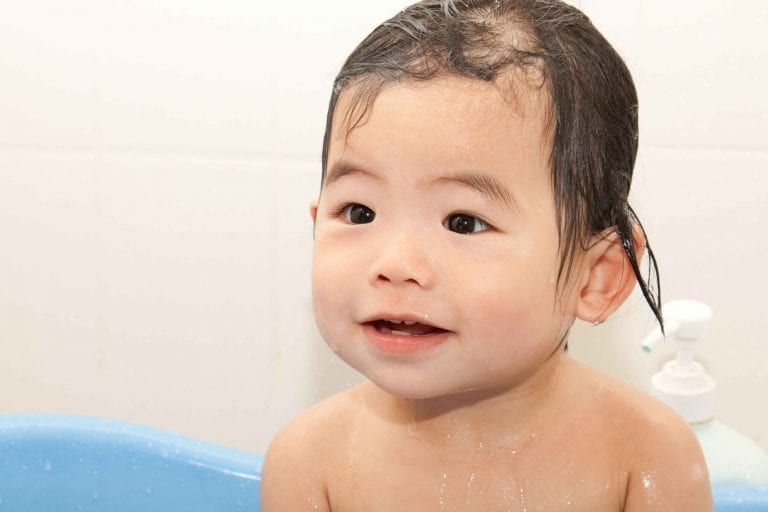Splish, Splash in a Safe Baby Bath
Every parent has questions about making a safe baby bath—you’re not alone. Here are the most common questions nurses receive—and our best advice. Suds up!
How Often Should I Bathe My Baby?
Bath time is really more about fun as babies usually don’t get very dirty. Daily bathing isn’t recommended as it can dry delicate skin; research shows 2-3 times a week is best. Once your baby starts crawling, playing outside and feeding herself, more frequent baths will likely be needed.
Pick a time of day that works best for you both. Some babies are energized by bath time, others become relaxed and sleepy.
Checklist for a Safe Baby Bath
- Choose a warm room without drafts or breezes
- Prepare a bathtub, infant bathtub, sink or basin
- Place a towel or foam pad in the bottom of the bath
- Set everything you will need within arm’s reach without letting go of baby
- A stack of extra towels for drying baby; some parents like to warm them in the dryer in preparation for baby’s bath
- Cleansers made for washing infant skin
- Shampoo made for washing baby’s hair and scalp
- Several wash cloths
- Cotton balls
- Wipes made for cleansing infant skin
- Clean clothes for baby
- Fresh diaper
- Diaper rash protection cream
What’s the Best Way to Bathe my Newborn?
The first step in baby’s bath routine is always to get everything ready for the bath–use our handy checklist to ensure you have everything you need at your fingertips. Once these are set in place, you’re ready to begin baby’s bath.
For a sponge bath, use a clean washcloth rinsed in a basin of warm water, exposing and washing one body area at a time while keeping everything else covered.
For a tub bath, go ahead and immerse baby from birth into a tub filled with warm water just deep enough to cover their shoulders and follow these safe baby bath tips:
- Use a baby washcloth, which is usually softer than a regular washcloth, to avoid irritating their skin
- Support their head and neck with your hand and forearm while bathing
- Place a warm washcloth over their immersed body to help keep them warm throughout the bath; this soothing, relaxing technique helps keep your baby’s temperature stable
- Prepare a stack of warm towels on the floor next to the bath to move baby from the bath onto; immediately wrap baby in one of the towels to help them retain the warmth of the bath
What Kind of Cleansers Should I Use?
Prevent irritation by using a mild preservative- and fragrance-free cleanser with a neutral pH designed specifically for baby’s delicate skin.
For your baby’s face, water alone is enough. You don’t have to clean her eyes at every bath; when necessary, gently wipe from the inside to the outside, using a clean part of the washcloth for each eye.
Post-Bath Pointers
- Pat baby dry with a soft, warm towel rather than rubbing vigorously.
- Lotions aren’t really necessary and can actually lead to more drying of the skin.
- Never use powders on your baby, which can be inhaled and lead to breathing problems.
- Skip cotton swabs, which can damage the ear canal and eardrum
You’ll become more comfortable and confident with each bath you give. Go ahead, grab that rubber ducky and get splashing!
What About the Umbilical Cord?
Previously, parents were advised to avoid tub baths until the umbilical stump had fallen off to avoid an increased risk of infection. However, the latest research shows the risk of infection is actually no higher, and there’s no need to keep the cord dry or add ointment as it prepares to fall away. Ask your nurse if you have any questions about cord care.
Baby Bath Safety Tips
- Never, ever leave baby unattended in the water, not even for a second! Babies can very quickly drown in the slightest amount of water
- Bathe baby in a warm area free from drafts—75oF is a good room temperature
- Have all of your supplies ready and within reach so you can keep one hand on your baby at all times
- Baby bathtubs are nice, but a sink works, too! Once your baby is older and can sit up, your regular tub can be used with modifications: bath rings, tub mats and faucet covers
- Eliminate all distractions—turn off your cell phone!
- Don’t place baby in the tub until the water is finished running, as the temperature could change suddenly
- Keep the water level no deeper than your baby’s shoulders
- Set your water heater to no more than 120 degrees Fahrenheit to avoid accidental scalding
- Use a thermometer specifically designed for the bathtub to reach an ideal temperature of about 100.4o F. Some devices even have audible alarms to warn you if the water is too hot or too cold





Comments are closed.